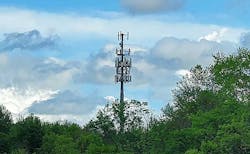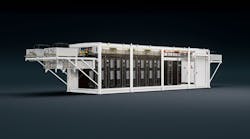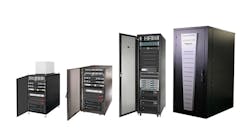During the COVID-19 pandemic, employees across the globe are working from home. Will this newly-distributed workforce accelerate adoption of edge computing? As we continue our Data Center Executive Roundtable, we put this question to our panel of experienced data center executives: Phillip Marangella of EdgeConneX, CoreSite’s Steve Smith, Scott Walker from NTT Global Data Centers Americas, John Sasser of Sabey Data Centers, and Nancy Novak from Compass Datacenters and Infrastructure Masons.
The conversation is moderated by Rich Miller, the founder and editor of Data Center Frontier.
Data Center Frontier: The workforce is suddenly more distributed than ever. What’s your take on the current trajectory of edge computing? Has it been changed in any way by the pandemic?
STEVE SMITH, CoreSite
Steve Smith, CoreSite: Network technologies, including edge computing and 5G, are now more critical than ever. With a large portion of the US workforce remote and working from home, there has been a significant shift in network traffic. Before, daytime network traffic was high in dense, business districts. Now, most of that traffic is in residential areas. Providers of cable, video conferencing, phone systems, internet and many others, route traffic back to a network-dense data center in key metro areas.
This shift has increased the importance of edge computing. For example, Cisco Webex hosted 20 billion meeting minutes in April, according to the May 14th update on Data Economy’s live COVID-19 page. That kind of network traffic wouldn’t work without edge data center deployments. People expect the same real-time processing speeds at home, as they’re used to having in the office.
As more companies turn to cloud-based virtual desktop infrastructure (VDI) services, the focus will shift to interconnection. Edge meets at connectivity. Choosing a data center provider with a rich ecosystem of customers is vital. It seems that remote work is our new reality, and companies might continue this trend as they decrease office space to save on capital expenses.
We see more and more companies speeding up their digitization efforts. In some cases, deployment timelines are decreasing and expected data-processing speeds are increasing. At CoreSite, we have native cloud onramps to major public cloud providers – AWS, Microsoft Azure ExpressRoute, Google Cloud Platform, Oracle Cloud – which allows for multi-cloud and hybrid-cloud IT infrastructure configurations. Additionally, The CoreSite Open Cloud Exchange allows for increased or decreased connectivity in real-time. These are the types of answers that companies need.
PHILLIP MARANGELLA, EdgeConneX
Phillip Marangella, EdgeConneX: From what we’ve learned during the pandemic, there is little doubt that the operations and service strategies of cloud, content, network and other solution service providers will be forever changed. Our homes have essentially become the new edge, where we now work, study, game and entertain simultaneously. At the same time, new next-gen technologies such as IoT-enabled devices, autonomous vehicles, machine learning and AI tools, augmented and virtual reality (AR/VR), and smart city applications, to name a few, will also place a strain on network infrastructure.
The combined increase in the volume, velocity and variety of data traffic flows coming from both scenarios will generate significant service delivery challenges. The solution to these network bottlenecks lies in edge data centers where network, cloud and content service providers can peer and optimize their traffic flows for both performance and cost. The edge is the lowest latency point of demarcation between service delivery and latency. Therefore, placing content, applications, compute games and data in general as proximate to end users as possible will be essential to ensure the quality of service and experience for customers.
SCOTT WALKER, NTT Global Data Centers, Americas
Scott Walker. NTT Global Data Centers: Because it is such a great technology, edge computing suffers from premature hype from those who are hopeful of futuristic technology arriving before it is really ready. For instance, edge has long been considered the key for self-driving cars, which many people thought were coming on strong last year. Then an article in the New York Times last July slammed the brakes on that hype. After all, when the CEO of Ford says ““We overestimated the arrival of autonomous vehicles” then you know we have a ways to go.
But as far as the effect of the COVID-19 pandemic on edge computing, I’ve read opinions from analysts like ABI Research’s Dimitris Mavrakis, who says that over the course of the next two years the edge computing space (both dedicated and shared edge) will be a very contested topic, and certainly the effects of geopolitics and COVID-19 will accelerate it.
Grand View Research tracks the size of the global edge computing market in great detail, and projects a hockey-stick curve of growth between now and 2027. As Grand View points out, edge computing can help meet demand for data analytics across many industries, overcome the challenges of network latency, and provide immediate real-time insights in crucial situations. With that kind of problem-solving power, there will be an increasing demand for edge computing for a long time to come.
NANCY NOVAK, Compass Datacenters and iMasons
Nancy Novak, Compass Datacenters & iMasons: Conceptually I think that we’ll see companies realizing customer satisfaction and application performance is going to require moving compute and storage closer to end users, but with one man’s edge being another’s conveniently located colo facility, it’s going to be very difficult to quantify the growth in “edge computing.”
Despite the hype, you could argue that the optimal model for providing localized data center functionality is still unclear. Who are the real players going to be and how will these capabilities be deployed and productized is still an open question, and how much of the “marketplace” will be made up of enterprises, cloud providers, et. al. implementing their own extended networks remains to be seen.
The post-pandemic world will certainly prod a number of companies that have been taking a wait and see approach to begin looking how edge computing fits into their overall strategy, but it’s going to take a few years to sort things out to the point that we can actually say what, if any, impact COVID had on market momentum.
JOHN SASSER, Sabey Data Centers
John Sasser, Sabey Data Centers: Of course, there has been volatility in demand with the falling off of some industries – hospitality, etc and an obvious increased distribution of technology workload associated with work from home, school from home and technology as entertainment in the home (e.g. videos and social media) and consequently, more demand at the edge for computing and communications. Most users have reported no problem in their ability to conduct these activities with existing infrastructure. Others do not have the infrastructure to be able to fully take advantage of these opportunities. Of course, these inequities often have more to do with connectivity than the location of the core processing functions.
We might expect to see more legacy companies evaluating their capacities in light of COVID’s testing of the infrastructure. This demand will continue to grow as more companies re-evaluate their formal Work From Home programs and as the prospect of the impacts of 5G, mobile and next generation apps looms.
NEXT: The data center supply chain and the COVID-19 pandemic .
Keep pace with the fact-moving world of data centers and cloud computing by following us on Twitter and Facebook, connecting with me on LinkedIn, and signing up for our weekly newspaper using the form below:








